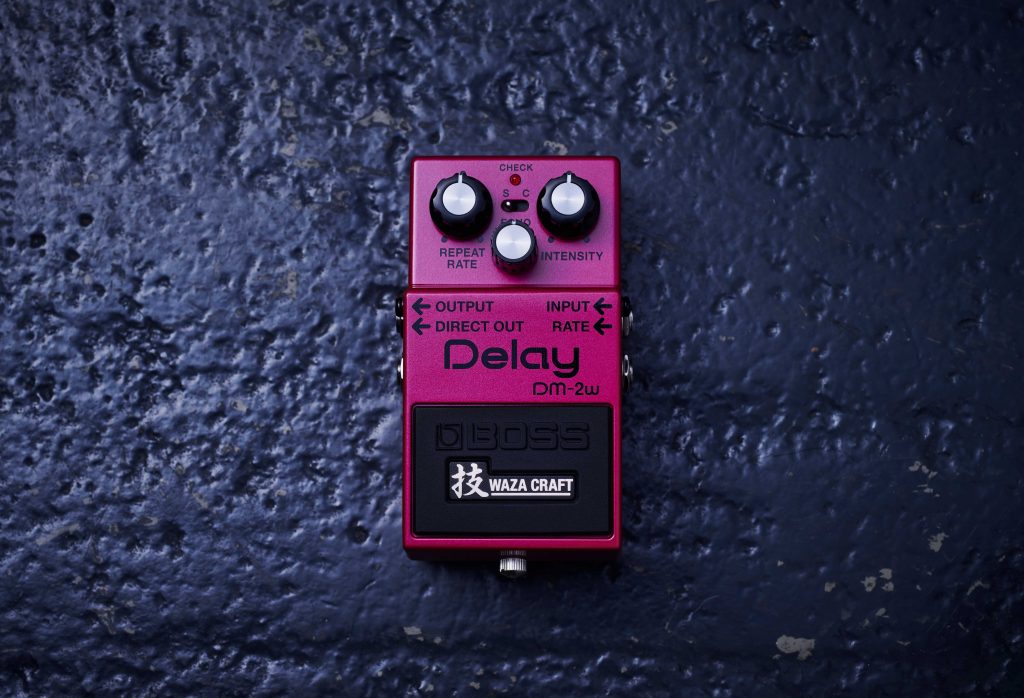A Tale of Borrowed Time
Perhaps it was the first time I heard East Bay Ray’s sinister intro to “Holiday in Cambodia.” Maybe it was when I became transfixed by Neil Young’s silver screen mind-melting soundscapes from the film Dead Man that changed me. Whatever the eureka moment, one thing was certain: echo was going to guide my guitar sound from there forth.
When such things were affordable, I aped my heroes by gigging with a 78 JMP crowned with an EP-3 Echoplex. It was perfect for the spacey surf-punk band I was playing in at the time. Eventually, the heft, expense, and maintenance became too much. So, I began looking for a more stage-friendly alternative that could run straight into the input and blend into my signal.
"A friend of mine brought over a battered little magenta BOSS box that he had found in his closet."
A Lucky Meeting
Luckily, a friend of mine brought over a battered little magenta BOSS box that he had found in his closet. It sounded amazing while riding the Rate and Intensity controls in dub-style treatments with my vintage SH-101 synth. I knew this could be the ticket. My buddy graciously let me long-term borrow his 1981 DM-2, the only pedal I’d used for years.
The old Marshall drank in the frequency and slight saturation of the repeats perfectly. It created space while maintaining the diction of my pick attacks. I felt a real kinship with this pedal, born the same year as myself. The DM-2 offered everything from perfect slap-back to 300ms of pure magic that curiously never sound out of time in a live situation.
Ironically, at the time a vintage DM-2 would set you back near the same amount of money as a vintage Echoplex. As a result, it gutted me when I had to return the pedal to my friend when I moved to the UK. My love affair with DM-2 was over, for a time.

The Ways of the WAZA Bucket Brigade
Many years later, when the BOSS WAZA line announced the DM-2W, I procured one as fast as I could. To my delight, the Standard Mode behaved exactly like my old fling. Even better, many new and welcome features were there to explore in the pedal.
Being a bit of a stereo nut, I was now able to go straight into two amps and enjoy some thickening by setting the Rate to 2 o’clock with Intensity before noon. This is a great solution for those who wish to go wide without employing modulation solutions. Flipping over to Custom Mode on the DM-2W is where the real fun begins and now, with expression pedal control, we can get wild.
"My favorite thing is to set the Intensity to 11 o'clock, at the cusp of self-oscillation."
Iconic Oscillation
Currently, my favorite DM-2W trick is to set the Intensity to 11 o’clock, at the cusp of self-oscillation. The idea is to go toe-up bathtub reverb while arpeggiating. Then, I dive back heel-down as I hit a chord to plunge the repeats into a rubbery chasm that undulates under my strums.
It’s a characterful, yet musical, analog approximation of the “whammy” effect. Additionally, it’s a fine example of how this seemingly traditional tone box is full of time-warping surprises. After almost 40 years of life, many spent with the iconic DM-2—and its succesor, the DM-2W—the love continues to grow.







